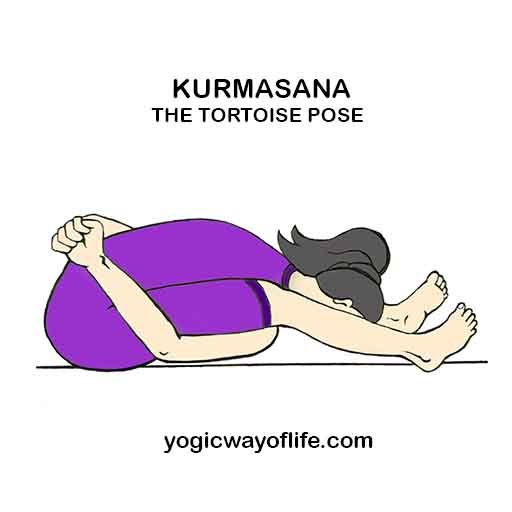Kurmasana or the Tortoise Pose is so called because the asana looks like a tortoise in the final pose. In Sanskrit, Kurma means tortoise. When we observe a tortoise, we see that only the hands and legs protrude out from the shell. In the final position, this asana imitates the tortoise. Kurmasana tones the entire abdominal muscles, removes belly fat and is good for diabetes.
This asana is mentioned in the Gheranda Samhita, though the popular version practiced today is slightly different from what is mentioned in the classical text.

How to do Kurmasana (The Tortoise Pose) ?
- Sit on the floor with the legs spread out in front of you.
- Bend forward with the forehead almost touching the floor in front of you.
- Pass the hands under the knees.
- Bend forward to touch the forehead to the ground and slide the hands further under the knees towards the back. Exhale as you bend forward.
- Clasp the two hands behind the back. This is the final position.
- Practice normal breathing in the final position. Relax your abdomen and back muscles in the final pose.
- Maintain the position for as long a comfortable. During the final stage, awareness must be on relaxing the back and spinal muscles and on the slow rhythmic breathing. For spiritual benefits, one may also concentrate on the Swadhistana or Manipuraka Chakra.
This is a forward bending asana. Hence always precede or follow this with a backward bending asana like Bhujangasana, Matsyasana, etc.
Benefits of Kurmasana (The Tortoise Pose)
- Kurmasana gives a good stretch the spine and tones it.
- It tones all the organs in the abdomen.
- It is good for those suffering from diabetes, constipation and belly fat.
- It removes pain in the back and neck.
- Kurmasana can help to relieve some headaches.
Contraindications for Kurmasana
- Those suffering from sciatica and slipped disk should avoid this asana.
- Those having hernia and chronic arthritis should not do Kurmasana.
